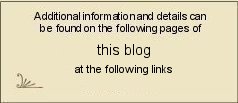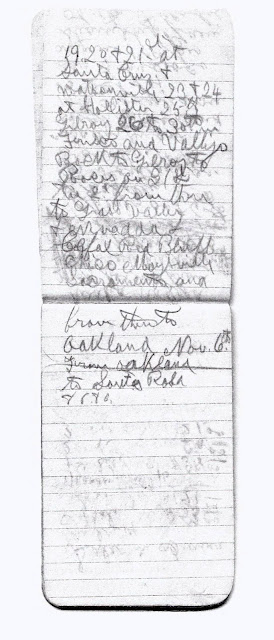OAPY SMITH IN CALIFORNIA
♫ California's the place you outta to be
So he loaded up his grip and moved to Grass Valley ♪
This is page 14, dated 1882, the continuation of deciphering Soapy Smith's "star" notebook from the Geri Murphy's collection. A complete introduction to this notebook can be seen on page 1. Page 14 is a continuation from page 11, 12 and 13, concluding on page 14, which is what we are visiting today.
Note that these notebook pages have never been published before! The pages continue to be not only of revealing interest but also of rewarding surprise! It initially seemed that pages 11 through 13 were composed in San Francisco. But as this next page directly continues from page 13, and if this page is the last of the list of places, then probably the list was composed later than in San Francisco. I guess it hardly matters, though, because what's of most interest is where and when the visits occurred. The picture that the pages draw is of young 22 year-old Jefferson pursuing "soap sales" over a very wide spread of territory and in a very tenacious, even driven, way. From the end of July until the first week of November, Jeff was on a perpetual motion swindle campaign.
The notebook(s) are in Soapy's handwriting, and often times pretty hard to decipher. A large part of this series of posts is to transcribe the pages, one-at-a-time, and receive help from readers on identifying words I am having trouble with, as well as correcting any of my deciphered words. My long time friend, and publisher, Art Petersen, has been a great help in deciphering and adding additional information.
The notebook(s) are in Soapy's handwriting, and often times pretty hard to decipher. A large part of this series of posts is to transcribe the pages, one-at-a-time, and receive help from readers on identifying words I am having trouble with, as well as correcting any of my deciphered words. My long time friend, and publisher, Art Petersen, has been a great help in deciphering and adding additional information.
I will include the original copy of each page, an enhanced copy of each page, a copy in negative, and a copy with typed out text, as tools to aid in deciphering the notes. There are a total of 24 pages. This means that there may be upwards of 24 individuals posts for this one notebook. Links to the past and future pages (pages 1, 2, 3, etc.) will be added at the bottom of each post for ease of research. When completed there will be a sourced partial record of Soapy's activities and whereabouts for 1882-1883.
Important to note that the pages of the notebook do not appear to be in chronological order, with Soapy making additional notes on a town and topic several pages later.
Rather than plans to go somewhere, this page is an accounting of where Soapy has already gone. Page 13 covered his travels through Oregon, Washington Territory, and California in 1882. This page (#14) covers his journey and work in California. Previous pages contained to do lists, work notes, an itinerary. This page engages in journaling—the recording of past events, perhaps for the purpose of revisiting them, or memorializing them for oneself, like a diary entry. The interesting thing is that, although the writing records the communication of twenty-one-year-old Soapy Smith with himself, the writing also communicates with us about him 142 years later (and potentially far beyond today).
Below are my attempts to attempts to make the writing easier to see and decipher.
Below is what I believe to be the correct deciphering of the text, dated 1882. Do you agree, or do you see something else? All comments, suggestions and ideas are welcome! I will update the new information to this post.
 | |
(Click image to enlarge) |
Page 14
- Line 1: "19, 20, 21st at"
- Line 2: "Santa Cruz [California] + [and]"
- Line 3: "Watsonville [California] 23 + [and] 24"
- Line 4: "at Hollister [California] 25th"
- Line 5: "Gilroy [California] 26 to 30th in + [and] 24"
- Line 6: "Frisco [San Francisco] and Vallejo [California]"
- Line 7: "Back to Gilroy [California] to"
- Line 8: "Roses [short for Roseville] on 31st"
What looks like "Roses" I am certain is short for "Roseville." It was a major railroad junction (just called "Junction" early on) for the Central Pacific Railroad. It is said to have been named for the roses that grew in abundance in the area. I determined the cite had to be Roseville by consulting an 1882 railroad map from the Library of Congress. I followed possible routes from Gilroy to Grass Valley and Nevada City, and Roseville is the closest possible name to what Jeff jotted in the notebook. Here is how it's shown on the map, "Rose V."
 |
| "Rose V" 1882 railroad map Courtesy Library of Congress |
- Line 9: "till [until] 2nd from there"
- Line 10: "to Grass Valley [California]"
- Line 11: "+ [and] Nevada [short for Nevada City]"
This is "Nevada" for "Nevada City," incorporated in 1851. "City" was added in 1864 to distinguish it from the newly-admitted adjoining state to the east. Grass Valley and Nevada City, both 1849 gold rush towns, had rich mines in proximity, some producing ore until 1900. Back then, trains ran to them when the locations had economic vitality.
- Line 12: "Colfax [and] Red Bluff [California]"
- Line 13: "Chico [and] Marysville [California]"
- Line 14: "Sacramento [California], and"
- Line 15: "From there to"
- Line 16: "Oakland [California] Nov. 6th"
- Line 17: "From Oakland [California]"
- Line 18: "to Santa Rosa [California]"
- Line 19: "86.86."
The numbers on line 19 suggests that money is being indicated. Could that be a tally of "soap sales" receipts from Santa Rosa? Or could it be a tally of the cost of train fare to all the California locations he visited on the Central Pacific Railroad?
Since I had crawled through the 1882 railroad map I was drawn to tracing the locations on a map, which is attached. Of course, the arrows are as the "crow flies." The actual routes, as the 1882 map shows, were curving (though some straight) and involved train changes at places like Colfax and Sacramento (and probably some others) and a ferry ride to Vallejo from San Francisco.

STAR NOTEBOOK
April 24, 2017
Part #1
Part #2
Part #3
Part #4
Part #5
Part #6
Part #7
Part #8
Part #9
Part #10
Part #11
Part #12
Part #13
Part #15
Part #16
April 24, 2017
Part #1
Part #2
Part #3
Part #4
Part #5
Part #6
Part #7
Part #8
Part #9
Part #10
Part #11
Part #12
Part #13
Part #15
Part #16
"Your best chance to get a Royal Flush
in a casino is in the bathroom."
—V.P. Pappy






























